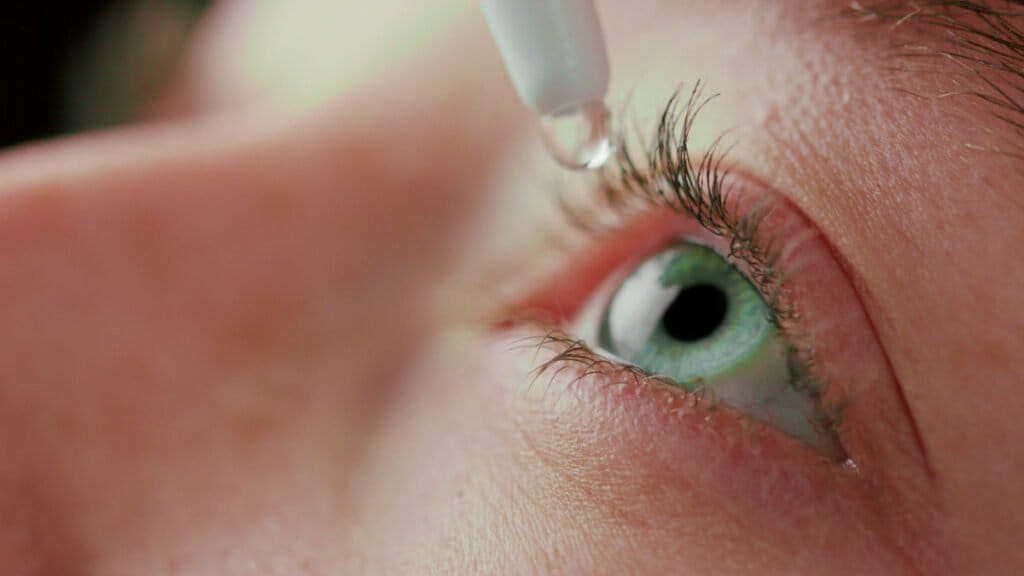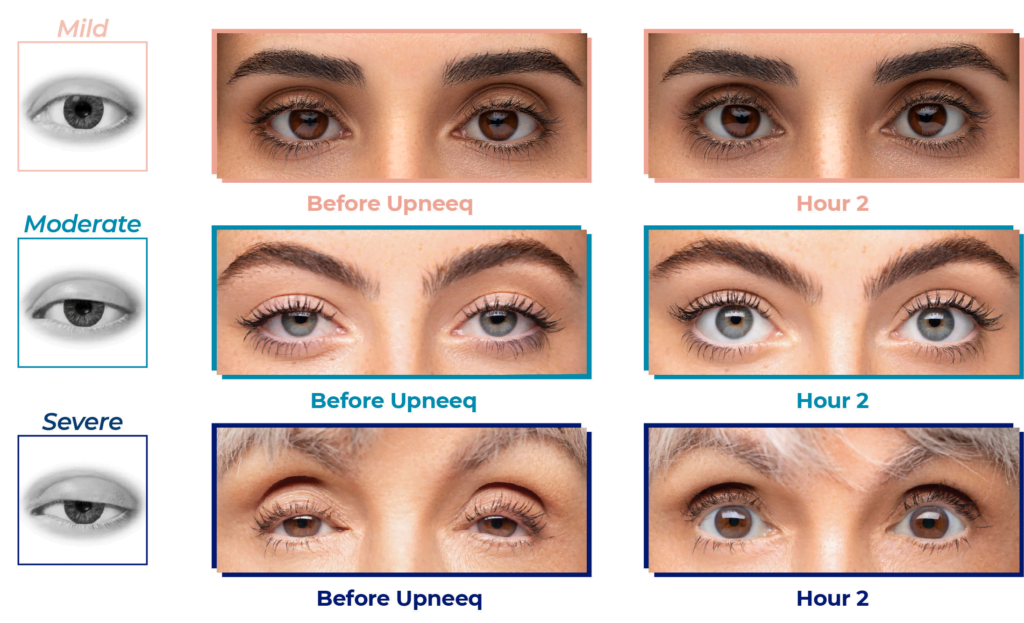Here’s What You Need to Know about Upneeq, the FDA-Approved “Eyelid Lifting” Drops
| ABCS
While it may sound like science fiction, the FDA-approved eye lifting drop is real: UPNEEQ® is a prescription eye drop that temporarily improves droopy eyelids, or ptosis, with a single daily dose. While you won’t get the more dramatic results you can expect from eyelid lift surgery, patients see an average of about 1 mm of lift in their upper eyelid after the first use—just enough to make a noticeable difference.
For cosmetic surgeons, this first-of-its-kind non-surgical treatment for eyelid ptosis creates an option that many patients will benefit from, including those not ready for eyelid surgery or who are suffering from low-lying eyelids due to BOTOX® injections. Below, we answer your top questions about Upneeq.
What are droopy eyelids (blepharoptosis)?
The medical name for droopy eyelids is blepharoptosis (blepharo = eyelid, ptosis = sagging). Eyelids that droop may lead you to appear tired, and your eyes may look smaller than they normally are. It can also interfere with the function of your eyes.
Droopy eyelids have numerous possible causes, including aging, genetics, eye surgery, certain underlying medical conditions, or even Botox that inadvertently travels to the eyelid muscles after injection in the forehead.
What is acquired blepharoptosis, and how is it different?
Droopy eyelids may be either congenital (present from birth) or acquired, which means that they develop over time (i.e. because of aging). Congenital droopy eyelids cannot be treated with Upneeq, and may require corrective surgery. Acquired blepharoptosis may be treated with Upneeq.
If the cause of your droopy eyelids is unclear, but sure to visit an ophthalmologist first for an eye exam to rule out an underlying medical condition. Serious neurological or eye conditions can also cause eyelid ptosis, including stroke and/or cerebral aneurysm, Horner syndrome, myasthenia gravis, external ophthalmoplegia, orbital infection, and orbital masses.
How are droopy eyelids treated?
Many patients seek eyelid lift surgery to treat cases of droopy eyelids, whether for cosmetic or medical reasons. Upneeq is a revolutionary second option: it is the first treatment specifically approved by the FDA to treat acquired droopy eyelids.
How does Upneeq work?
Upneeq (oxymetazoline hydrochloride ophthalmic solution), 0.1% is an eye drop that should be inserted once a day, one drop per eye. (Each single-use vial of Upneeq contains enough solution to treat one or both eyes at a time.) Upneeq contains oxymetazoline, an alpha adrenergic agonist that triggers the levator palpebrae muscle (Muller’s or Mueller’s muscle), causing the muscle to contract and raise the upper eyelid.
Upneeq works by stimulating an involuntary eyelid muscle, the Muller’s muscle, to contract.
In clinical studies, the average amount of upper eyelid lift was 1 mm. While this minor lift will not give you the dramatic results possible with surgery, this small lift can be cosmetically and/or medically beneficial to many patients.

Photo: Upneeq
How long does Upneeq last?
Each dose (one drop daily) of Upneeq was shown to be effective for at least 6 hours in clinical studies.
Is Upneeq FDA-approved to be safe and effective?
Yes, Upneeq is FDA-approved to be both safe and effective for the treatment of acquired eyelid ptosis in adults. To gain FDA approval, Upneeq showed effectiveness in two 6-week trials that followed 304 patients with acquired blepharoptosis. A third study was also conducted to establish that the eye drop is safe.
The main ingredient in Upneeq, oxymetazoline hydrochloride, is the same primary ingredient in decongestant nasal spray, such as Afrin®. In nasal spray, the ingredient works by stimulating the blood vessels to contract, while in Upneeq, this ingredient works to stimulate eyelid muscle contraction.
A single drop of Upneeq gives most patients a temporary eyelid lift of about 1 mm.
What are the side effects from Upneeq?
In clinical trials, a range of side effects were observed in 1-5% of patients and included eye inflammation or irritation, redness, dry eye, blurred vision, headache, redness in the lining inside and at the front of the eye (conjunctival hyperemia), and inflammation of the cornea (punctate keratitis). Eye pain is also possible around the time that Upneeq drops are used.
How many times a day can I use Upneeq?
Upneeq should only be used as prescribed: one dose, once daily. Work with your doctor to decide how long it is appropriate for you to use Upneeq, and follow their recommendations.
Can Upneeq cause rebound redness?
Using Upneeq may lead to rebound redness (rebound hyperemia), which can occur with use of certain eye drops, such as Visine® or other over-the-counter products, that relieve redness by constricting blood vessels. Rebound redness is a persistent redness that develops after your eye becomes accustomed to a redness-relieving eye drop. While Upneeq is not prescribed for redness relief, the active ingredient may constrict blood vessels, and could lead to this redness. Contact your doctor if you experience more redness than normal, or any other symptoms, while you are using Upneeq.
Upneeq underwent thorough clinical trials to receive FDA-approval for acquired blepharoptosis, or “droopy eyelids.”
Can I use Upneeq with my other eye drops?
Yes, you can likely use Upneeq with other eye drops. After using Upneeq, wait 15 minutes before using any other eye drops (or inserting contact lenses). Be sure to talk to your doctor about all of the prescription and over the counter medications and eye drops you use in your consultation to ensure that they are safe to use with Upneeq.
Who is a good candidate for Upneeq?
If you have mild, moderate, or severe eyelid ptosis (sagging), and you are not taking any medications that will interfere with Upneeq, then you may be a good candidate for the eye-lifting drop. Disclose all of your medications and supplements, as well as your medical history, with your board certified cosmetic surgeon or ophthalmologist in order to determine if you are a good candidate. Upneeq may affect blood pressure and amine metabolism, and therefore may interfere with certain prescription medications, including:
- Beta-blockers
- Anti-hypertensive medications
- Cardiac glycosides
- Monoamine oxidase inhibitors
How does Upneeq compare to eyelid lift surgery?
Upneeq helps those with acquired blepharoptosis, or droopy eyelids that develop over time, and is ideal for temporary use—but it can only achieve mild improvement of ptosis. As such, Upneeq is not a substitute for eyelid lift surgery (blepharoplasty), which offers results that are lasting and can treat both genetic and acquired droopy eyelids. Upneeq can be considered a helpful but temporary alternative to surgery for those who are not prepared to have a surgical eyelid lift.
What is Botox-induced ptosis?
Botox-induced eyelid ptosis happens when Botox injected into the forehead migrates to your eyelid muscles. As the Botox causes the muscles to relax, you may experience low-lying eyelids.
Can Upneeq eye drops be used to treat Botox-induced ptosis?
Yes, Botox-induced droopy eyelids may be treated with Upneeq. The effects of drooping eyelids after Botox injections are temporary; while Botox wears off after 3-4 months, the unwanted effects on the eyelid muscle typically wear off even more quickly. Upneeq may be used in the interim to stimulate the eyelid to elevate more normally.
If you are suffering the effects of Botox that migrates to your eyelids, Upneeq can help.
If you experience Botox-induced eyelid ptosis, be sure to talk not only to your board certified cosmetic surgeon or ophthalmologist, but also to your injector. While an inexperienced injector may make mistakes that lead to this issue, even seasoned injectors may, in some cases, inject Botox that migrates. They should be able to adjust the placement of your injections in the future to prevent the issue.
How much does Upneeq cost?
Upneeq costs $160 for a 30-day supply and $240 for a 45-day supply.
Find a board certified cosmetic surgeon for a full range of eyelid ptosis treatment options
If you are looking for an eyelid lift, you want to know about all of your options—surgical and non-surgical. Visit a board certified cosmetic surgeon for safe and effective options ranging from ophthalmic drops, to nonsurgical skin tightening, to surgery. Find a surgeon in your area now.
